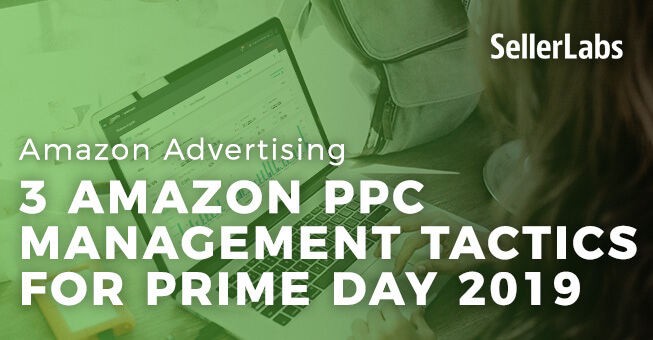3 Amazon PPC Management Tactics for Prime Day 2019
Use these 3 Amazon PPC management tactics for Prime Day 2019. You’ll get more traffic to your products, increase sales, and reduce wasted ad spend.
Unless you’ve been using an Amazon selling playbook from 2007, you’re probably aware of the advent of Amazon Sponsored Products and Sponsored Brands advertising. And much like jumping into a lake on a hot summer’s day, many sellers may not comprehend the depth of what they’ve gotten themselves into. Here are three Amazon PPC management tactics for Prime Day 2019, sure to help sellers spend less and get noticed more.
Top 3 Amazon PPC Management Tactics for Prime Day 2019
The Amazon PPC management tactics listed below will help your products get noticed more and reduce wasted ad spend for Prime Day 2019. Likewise, these tactics can be used throughout the year and are generally regarded as best practices.
Tactic #1: Run ads for your branded keywords.
First off, what are branded keywords? These are the keywords that are or contain your brand’s name. For example, if you sell Garmin watches on Amazon, you would want to target ads for the branded keyword “Garmin.” This is because “searchers who use branded keywords are more likely to be familiar with the brand.” What’s more, paid branded keywords can be four times more likely to convert when compared to their organic counterparts.
Okay, so what does this mean for you?
You’re losing sales by not running ads for your branded keywords. And chances are that your competition is running ads for your branded keywords and taking sales from you.
Amazon gives brand owners an undisclosed discount for their own branded keywords. This means you can deter competitors from making sales off of your branded keywords. You can do this by setting the bids for your branded keywords higher than normal. Ensuring that your competition will get charged more per click for each one of your branded keywords they’re running ads for.
This tactic will make competitors think twice about investing money into ads that aren’t their own branded keywords.
Tactic #2: Avoid running out of advertising budget early in the day.
There seems to be a “set-it-and-forget-it” mentality amongst Amazon sellers when it comes to advertising. Oftentimes, this leads to sellers running out of advertising budget too early in the day and not knowing why.
If you run out of ad spend early, you should increase your advertising budget for that day so your campaign(s) will still run. Then pull the Search Term Report to see where the clicks are coming from. Once you’ve identified where and how your advertising budget was spent, then you’ll be able to take the next steps to fix your problem.
In the Search Term Report, look for any search terms that have more than 10 clicks with no conversions (this is merely a general guideline; each category will yield different results and have a different cost per click). If a term is completely irrelevant to your product, you will want to convert it to be a negative keyword (either phrase or exact).
Additionally, check your sales report to find out what times and days see the most conversions. For days and hours that aren’t converting, consider turning off your ads in order to save your spend for better sales windows. You can use Ad Scheduling (aka Dayparting) to do this so that you only display your ads at opportune times. This may not be necessary during Prime Day since Amazon will be getting massive amounts of traffic, but it is something well worth considering year-round.
Tactic #3: Run campaigns for negative keywords.
Think of negative keywords as anti-keywords. If a keyword is a term that will get your product discovered then a negative keyword is a term that will block it. The goal of negative keywords is to prevent getting charged for clicks that don’t result in conversions.
So how do you know when you should be using negative keywords? Typically, if you see higher than normal ACoS percentages for a campaign (like in our example above, 10 clicks with zero conversions) then you need to convert keywords that don’t convert into negative keywords.
Negative keywords can only be set as a phrase match and exact match—no broad match negative keyword option is available. Set these keywords as negatives in an auto campaign with a corresponding manual campaign at a lower bid. This way, you’ll still be bidding on the relevant term in the manual campaign at a lower bid you can control.
You’ll start getting fewer clicks on keywords that don’t convert to sales with the more negative keywords you’re running campaigns for—which saves you money. This will pay off on high-traffic days like Prime Day and Cyber Monday when people are searching for products with their wallets open.
Next Steps for Your Amazon PPC Management
Prime Day 2019 is full of opportunities but there are just as many ways to make mistakes. Taking proactive steps in the weeks leading up to the summer-shopping holiday will boost your effectiveness for Prime Day. Becoming an expert advertiser takes time and patience. If you can avoid costly mistakes early, you’ll be leaps and bounds ahead of your competition this year.
That said, put the power of superior Amazon Advertising in your hands today! Sign up for your free 30-day trial of Ignite.
Need help managing your ad campaigns? The Seller Labs Amazon PPC Managed Services team is standing by to help manage your advertising so you can focus on other areas of your business.
